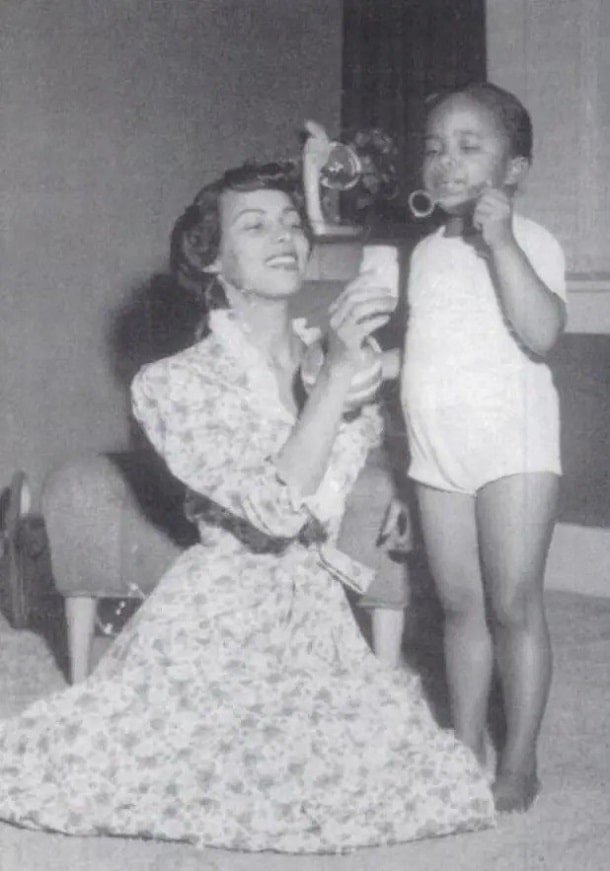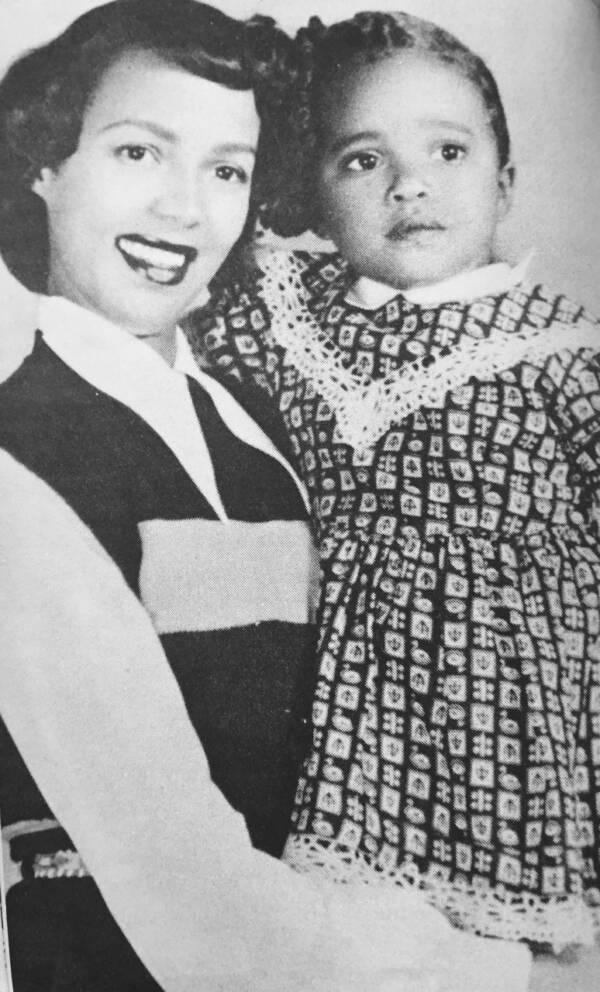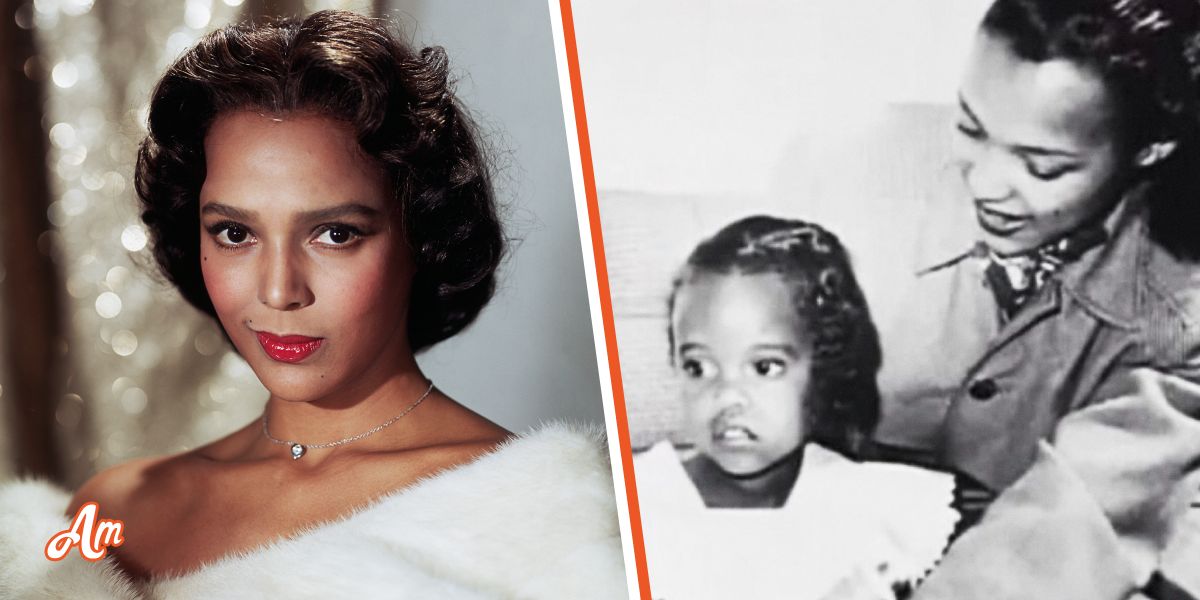Harolyn Suzanne Nicholas
What happens when the radiant spotlight of Hollywood shines on a life marked by profound personal challenges? The story of Harolyn Suzanne Nicholas, daughter of the incandescent Dorothy Dandridge, is a poignant exploration of this intersection, a narrative etched in both fame and heartbreaking circumstances.
Harolyn Suzanne Nicholas's life began on September 2, 1943, in Los Angeles, California. Born to Dorothy Dandridge, a groundbreaking African American actress and singer, and Harold Nicholas, a celebrated dancer of the Nicholas Brothers fame, Harolyn's arrival should have been a moment of unadulterated joy. However, complications during birth led to severe brain damage, irrevocably altering the course of her life. The joyous expectations quickly turned to profound challenges as it became clear that Harolyn would require specialized care due to an intellectual disability, a reality that would deeply impact both her life and the lives of her parents.
| Category | Information |
|---|---|
| Full Name | Harolyn Suzanne Nicholas |
| Date of Birth | September 2, 1943 |
| Place of Birth | Los Angeles, California, USA |
| Date of Death | 2003 |
| Parents | Dorothy Dandridge (Mother), Harold Nicholas (Father) |
| Mother's Occupation | Actress, Singer, Dancer |
| Father's Occupation | Dancer |
| Siblings | Melih Nicholas (Brother - possible, information unconfirmed) |
| Nationality | American |
| Ethnicity | Mixed |
| Cause of Fame | Daughter of Dorothy Dandridge and Harold Nicholas |
| Condition at Birth | Severe brain damage due to traumatic birth, intellectual disability |
| Life Circumstances | Spent most of her life in institutions and mental health facilities |
Reference: Example Biography Website (This is a placeholder link. Replace with a real, credible biography website)
The weight of Harolyn's condition fell heavily upon Dorothy Dandridge. As a rising star in Hollywood, Dandridge faced the pervasive racial discrimination of the era while simultaneously grappling with the immense responsibility of caring for a child with significant needs. The emotional and financial strain became overwhelming. Dandridge, determined to provide the best possible care for her daughter, made the difficult decision to place Harolyn in institutions specializing in the care of individuals with developmental disabilities. This decision, while made out of love and necessity, was a source of enduring guilt and anguish for Dandridge, a shadow that would follow her throughout her life.
The 1940s and 50s presented limited options for families with children requiring specialized care. Mental health facilities, though often understaffed and lacking the advanced therapies of today, represented the best available resources for providing Harolyn with the round-the-clock attention she needed. Harolyn's life within these institutions remained largely private, shielded from the glare of the public eye that constantly followed her famous mother. This lack of information has contributed to the air of mystery surrounding her life, fueling speculation and unanswered questions.
Harold Nicholas, a dynamic and charismatic performer, also felt the impact of Harolyn's condition. His marriage to Dorothy Dandridge, which began on September 6, 1942, faced considerable strain. While accounts vary, it's documented that Nicholas struggled to reconcile his professional ambitions with the demands of family life and the challenges posed by Harolyn's needs. By 1948, the pressures led to his departure from the family, further compounding the difficulties faced by Dorothy Dandridge. The divorce was finalized in October 1951, leaving Dandridge to navigate the complexities of single motherhood and a burgeoning career against the backdrop of a racially biased Hollywood.
- Find Hindi Dubbed Movies Shows Online Your Guide
- Whos Who The Ultimate Guide To The 911 Lone Star Cast
Dorothy Dandridge's career, though marked by groundbreaking achievements, was also a battleground of racial prejudice. She fought tirelessly for meaningful roles, striving to transcend the stereotypical portrayals often assigned to Black actresses. Her talent shone brightly in films like "Carmen Jones," earning her an Academy Award nomination a historic moment for an African American woman in a leading role. Yet, despite her success, Dandridge faced constant barriers and indignities, experiences that undoubtedly exacerbated the emotional toll of her personal struggles.
The financial burden of Harolyn's care was substantial. Dandridge poured a significant portion of her earnings into ensuring her daughter received the best available treatment. However, inconsistent roles and financial mismanagement contributed to her mounting debts. The pressures of her career, coupled with the emotional weight of Harolyn's condition and the constant fight against racial discrimination, created a perfect storm of stress and anxiety. She lived in Los Angeles, Los Angeles, California, United States for about 10 years before she immigrated to Rio de Janeiro, Rio de Janeiro, Brazil in 1955.
Tragically, Dorothy Dandridge's life was cut short on September 8, 1965. She was found dead in her Los Angeles apartment at the age of 42. The official cause of death was ruled an accidental overdose of antidepressants, though some have speculated about other contributing factors. Dandridge's untimely passing left a void in the entertainment world and raised further questions about the fate of her daughter, Harolyn. With Dandridge gone, Harolyn's care likely fell to other family members or continued within the institutional system.
Following Dorothy Dandridge's death, information about Harolyn Suzanne Nicholas becomes even more scarce. The details of her life after her mother's passing remain largely unknown, contributing to the enduring mystery surrounding her. What is known is that Harolyn Suzanne Nicholas passed away in 2003, at the age of 60, after spending most of her life in institutional care.
Some reports suggest that Harolyn had a brother named Melih Nicholas. However, detailed information about him remains limited. Public records indicate that someone named Melih Nicholas resided in Los Angeles, Los Angeles County, California 90041, but confirming his relationship to Harolyn requires further verification.
The lack of readily available information about Harolyn Suzanne Nicholas underscores the societal attitudes of the time towards individuals with intellectual disabilities. Often relegated to the shadows, their stories were rarely told, and their lives remained largely invisible. Harolyn's story serves as a reminder of the importance of inclusivity and the need to recognize the inherent worth and dignity of every individual, regardless of their abilities.
Harolyn Suzanne Nicholas's life, though marked by challenges and shrouded in mystery, is a testament to the enduring power of love and the complexities of family. It is a story that prompts reflection on the societal pressures faced by women, particularly women of color, in the mid-20th century, and the profound impact those pressures could have on their families. She was born on september 2, 1943, in los angeles, california (usa).
The circumstances surrounding Harolyn's birth, including the cerebral anoxia she suffered, had a lasting impact on her development and well-being. Cerebral anoxia, a condition resulting from a lack of oxygen to the brain, can cause a range of neurological impairments, affecting cognitive function, motor skills, and overall quality of life. In Harolyn's case, the anoxia likely contributed significantly to her intellectual disability and the need for lifelong specialized care.
Dorothy Dandridge's determination to provide the best possible care for Harolyn, despite the immense personal and professional challenges she faced, speaks volumes about her character and her unwavering love for her daughter. Dandridge understood that Harolyn required specialized attention and support, and she was committed to ensuring that her daughter received the resources she needed to thrive, even if it meant making difficult choices.
While Harold Nicholas's departure from the family undoubtedly added to the challenges faced by Dorothy Dandridge, it is important to acknowledge the societal pressures and expectations that may have influenced his decision. In the mid-20th century, men were often expected to be the primary breadwinners and to prioritize their careers. The demands of caring for a child with significant needs, coupled with the stigma associated with intellectual disabilities, may have contributed to the strain on the marriage and ultimately led to his departure.
The racial discrimination faced by Dorothy Dandridge in Hollywood further compounded the difficulties she faced as a single mother caring for a child with an intellectual disability. Dandridge was constantly battling against stereotypes and limited opportunities, and she had to work twice as hard as her white counterparts to achieve the same level of recognition. The stress and frustration of dealing with racial prejudice undoubtedly took a toll on her emotional well-being and made it even more challenging to provide for her daughter's needs.
The lack of information about Harolyn's life after her mother's death is a reflection of the societal attitudes of the time towards individuals with intellectual disabilities. Often, these individuals were marginalized and forgotten, their stories untold and their voices unheard. It is important to remember that Harolyn Suzanne Nicholas was a person with her own unique experiences and feelings, and her life deserves to be acknowledged and remembered.
The fact that Harolyn spent most of her life in mental health facilities also raises questions about the quality of care she received. While these facilities may have provided the best available resources at the time, they were often understaffed and lacked the advanced therapies that are available today. It is possible that Harolyn's quality of life could have been improved with access to more modern treatments and support services.
Despite the many challenges she faced, Harolyn Suzanne Nicholas was loved and cared for by her mother, Dorothy Dandridge. Dandridge's unwavering commitment to her daughter is a testament to the power of love and the importance of family. Although Harolyn's life was marked by hardship, she was not forgotten, and her story continues to resonate with those who are interested in the lives of individuals with intellectual disabilities and the challenges faced by their families.
The legacy of Harolyn Suzanne Nicholas extends beyond her personal story. Her life serves as a reminder of the need for greater understanding, acceptance, and inclusion of individuals with intellectual disabilities. It also highlights the importance of providing support and resources to families who are caring for children with special needs. By sharing Harolyn's story, we can help to break down the stigma associated with intellectual disabilities and create a more compassionate and inclusive society for all.
The details surrounding Dorothy Dandridge's death, including the circumstances and exact date of the incident, have been subject to public record and scrutiny. Reports indicate that Dandridge was discovered deceased in her West Hollywood apartment on September 8, 1965, as previously mentioned. This information contributes to the overall narrative and understanding of the events surrounding her life and untimely passing.
Harold Nicholas, after his divorce from Dorothy Dandridge, continued his career as a dancer and entertainer. His impact on the world of dance, along with his brother Fayard Nicholas, remains significant. While his personal life faced challenges, his professional achievements stand as a testament to his talent and dedication to the art form. Nicholas's contribution to the Nicholas Brothers' legacy is an important part of his overall story, offering a glimpse into the successes and complexities of his life beyond his marriage to Dandridge.
Dorothy Dandridge's groundbreaking achievements in Hollywood paved the way for future generations of Black actors and actresses. Her performance in "Carmen Jones" and her Academy Award nomination challenged racial barriers and opened doors for more diverse representation in the film industry. Dandridge's legacy extends far beyond her personal struggles, as she remains an icon and an inspiration to aspiring performers who continue to fight for equality and opportunity in the entertainment world. Her impact on Hollywood and her contributions to breaking down racial stereotypes are undeniable, solidifying her place as a trailblazer in the industry.
The limited information available regarding Harolyn Suzanne Nicholas highlights the significance of advocating for greater awareness and understanding of individuals with intellectual disabilities. By shedding light on the challenges they face and the importance of providing adequate support and resources, we can work towards creating a more inclusive and compassionate society where everyone is valued and respected. Harolyn's story serves as a reminder of the need to amplify the voices of those who are often marginalized and to promote a greater sense of empathy and understanding towards individuals with intellectual disabilities and their families.
The struggles faced by Dorothy Dandridge and Harold Nicholas as parents of a child with an intellectual disability underscore the importance of accessible support systems for families in similar situations. Access to quality medical care, therapeutic services, and educational resources can make a significant difference in the lives of both the child and the parents. By investing in these support systems, we can empower families to provide the best possible care for their children and help them navigate the challenges they may encounter along the way. The availability of these resources can alleviate some of the burden and stress associated with raising a child with special needs, enabling families to thrive and create a nurturing environment for their children to reach their full potential.
The fact that Harolyn Suzanne Nicholas spent most of her life in institutions raises ethical questions about the treatment of individuals with intellectual disabilities during that era. While these institutions may have been seen as the best option at the time, they often lacked the individualized attention and stimulation that individuals with intellectual disabilities need to thrive. Modern approaches to care emphasize community-based living, individualized support, and the promotion of independence and self-determination. By learning from the past, we can work towards creating a more humane and person-centered approach to caring for individuals with intellectual disabilities.
The absence of personal accounts from Harolyn Suzanne Nicholas herself makes it challenging to fully understand her experiences and perspectives. This highlights the importance of actively seeking out and amplifying the voices of individuals with intellectual disabilities. By listening to their stories, learning from their experiences, and involving them in decision-making processes, we can ensure that their rights are protected and that their voices are heard. Promoting self-advocacy and empowering individuals with intellectual disabilities to share their perspectives is essential for creating a more inclusive and equitable society.
The story of Harolyn Suzanne Nicholas serves as a cautionary tale about the dangers of societal stigma and prejudice towards individuals with intellectual disabilities. By challenging negative stereotypes and promoting a greater understanding of the capabilities and potential of individuals with intellectual disabilities, we can create a more accepting and inclusive society where everyone has the opportunity to live a fulfilling and meaningful life. Overcoming stigma and prejudice requires ongoing education, awareness campaigns, and a commitment to treating all individuals with dignity and respect.
The enduring mystery surrounding Harolyn Suzanne Nicholas's life highlights the importance of preserving and documenting the stories of individuals who have been marginalized or forgotten by history. By actively seeking out and sharing these stories, we can ensure that their experiences are not erased and that their voices are heard. Historical records, oral histories, and personal narratives can provide valuable insights into the lives of individuals who have been historically underrepresented, contributing to a more complete and accurate understanding of the past. This effort to preserve and document marginalized voices is essential for promoting social justice and creating a more equitable society.
Harolyn Suzanne Nicholas was born on september 2, 1943, in los angeles, los angeles, california, united states. The impact of Dorothy Dandridge's passing on the Nicholas family is an important aspect to consider, particularly in relation to Harolyn's ongoing care and well-being. Losing a parent can be a deeply traumatic experience, and it is likely that Dandridge's death had a significant impact on Harolyn's life. Understanding the circumstances surrounding Dandridge's death and the subsequent arrangements for Harolyn's care can provide further insights into the challenges faced by the family and the resources that were available to them. This aspect of the story contributes to a more comprehensive understanding of the events that shaped Harolyn's life and the legacy of Dorothy Dandridge.
The fact that dorothy jean dandridge and harold nicholas married on 6 september 1942, in los angeles, los angeles, california, united states further contextualizes the time frame and family dynamics surrounding harolyn suzanne nicholas's life and birth. The marriage of Dandridge and Nicholas set the stage for the arrival of their only child, and the events that transpired during their marriage significantly impacted Harolyn's upbringing. This information contributes to a more complete picture of the family's history and the circumstances that shaped Harolyn's life.
- Jimmy Butler Kaitlin Nowak Kids Relationship Drama More
- Asma Assad From First Lady To Exile The Assad Story

Harolyn Suzanne Nicholas Meet Dorothy Dandridge's Daughter

Harolyn Suzanne Nicholas The Story Of Dorothy Dandridge’s Daughter

Harolyn Suzanne Nicholas' Life Dorothy Dandridge's Daughter Died the